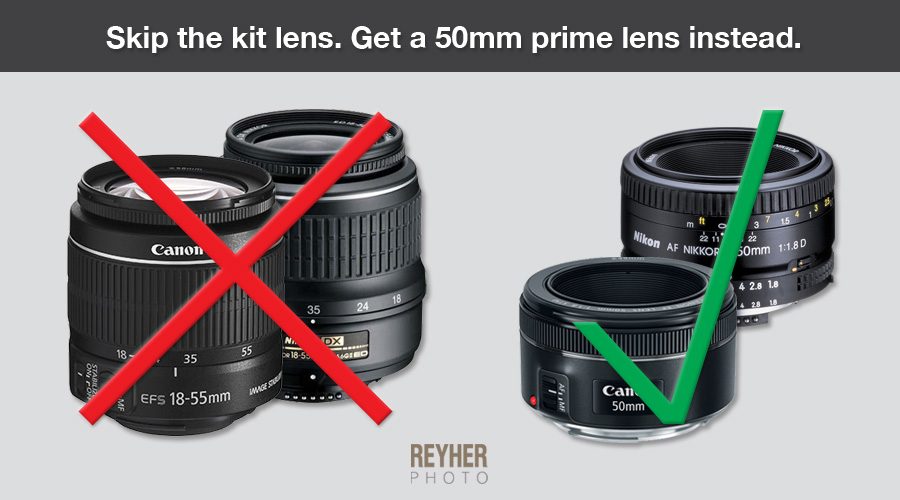As a beginner in photography, there is a very good chance your first camera will be a consumer grade DSLR. If you happen to get a lower-end DSLR, it will probably be offered as a package complete with 1 or 2 kit zoom lenses. While it may seem tempting to get both a camera and inexpensive zoom lenses that cover a wide range of focal lengths as a package deal, it’s not necessarily the best choice. In this article, you will learn why buying a fast 50mm prime lens is a much better option than settling for a slow kit zoom lens.
1. Cost
Photography can be a very expensive hobby and profession (at least if you shoot professionally, you’re getting a return on your investment). No matter whether you are a hobbyist or professional, you want to try and minimize your cost whenever possible. You can get 50mm prime lenses at very reasonable prices from a number of camera manufacturers, including both Nikon and Canon. 50mm f/1.8 prime lenses can cost as little as $125 brand new.
2. Image Quality
Of course not every 50mm prime lens is high-quality, but a vast majority of them are. Lens makers have figured out how to manufacture good quality 50mm lenses with excellent optical performance, and have been making them for a very long time. Generally, if something has been manufactured for a long time, it has improved greatly over time. The least expensive “nifty fifty” lenses often outshine their zoom counterparts.
3. Sharpness
50mm lenses are typically very sharp, and produce crisp images with minimal vignetting at the edges. You will not find a sharper lens for the budget price of $125 or so. Even if you have a kit lens that covers the 50mm focal range (a 17-55mm kit lens for example), a 50mm prime is worth the small investment. It will produce sharper, technically-superior images (provided you use the proper settings and know what you’re doing).
4. Lightweight & Compact
Camera gear is bulky, heavy and a pain in the ass to lug around. Well, a lot of it is anyway. A 50mm lens is small and lightweight, which makes it easy to carry with you and use without feeling like you’re pumping iron at the gym 🙂 It is a great lens to take with you while traveling, and can be used for a wide range of photo situations, from landscapes to portraits and much more.
5. Great Performance in Low Light
Generally, a 50mm prime lens has a maximum aperture of f1.8 or larger, which means you can use it in situations where you have very little available light. Instead of having to increase your ISO (which makes your images more grainy and degrades the overall image quality) as you would with a slow kit zoom lens, you can capture sharp images without much light by increasing your lens aperture. Remember to pay attention to your shutter speed, and if need be, increase your ISO. It’s better to have sharp images that have a little more noise (grain) in them, than blurry unusable photos because you didn’t want to increase your ISO.

6. Nice Bokeh Effect
Bokeh is the aesthetic quality of the blur in areas of your frame that are out of focus, and is especially useful for portraits. By effectively isolating your subject from its background, you direct the viewer’s eyes where you want them to go. 50mm prime lenses have a very shallow depth of field, and give you the ability to really blur the background, creating a nice bokeh. Other lenses (ones in the 80-100mm range) produce a better bokeh effect, but the 50mm prime lens bokeh is still pretty good. Keep in mind, a 50mm prime lens actually has a focal length of approximately 80mm on APS-C or crop sensors (Nikon DX and Canon EF-S or EF-M models).
7. Forces You to Move Around
With a kit zoom lens, you may tend to stand in one spot and rely on the zoom to compose a variety of shots. Using a 50mm prime lens, you will be forced to move around and search for the best possible vantage point. This will typically yield better results, and force you to view photographic scenes differently. By exploring a variety of perspectives, you will have more chances to capture truly unique images. Instead of staying in the same spot and zooming in and out, you will have to move around and get creative with your shots.
8. Versatility
50mm prime lenses are great for many different types of photography, from street to landscapes to candid shots and much more. It is a great lens to purchase as a beginner because you can use it to shoot many different subjects. Spend time honing your skills with this lens, and expand your collection of gear over time as your needs grow. It is nice to have a lot of gear, but remember that “gear does not the photographer make.” Your vision and unique perspective is what matters. Practice your craft with the gear you have at your disposal, and don’t worry too much about the gear you don’t currently own.
9. Similar to Your Field of Vision
Basically, when you look through a 50mm lens (on a full-frame camera), you are seeing the same field of vision that you do with your own eyes. This is particularly helpful in street photography, as it makes it easy to quickly and accurately compose your shots – you see a scene with your own eyes, then capture it with your camera. It helps you develop a vision for the final image. Of course, the frame in your camera does not extend as far as your field of vision, but you get the idea.
Conclusion
Hopefully, this post has shown you the distinct advantages of buying a fast 50mm prime lens instead of a slow kit zoom lens. Using the information in this post, you can now make an educated decision for yourself in regards to your first lens purchase. From great performance in low-light to excellent image quality and sharpness, the 50mm prime lens is a superb choice for the beginner photographer in need of a versatile lens for various types of photography. By no means am I saying that you cannot produce quality images with a kit lens. All views expressed on my blog are nothing more than my opinion, and should be regarded as such.
Did you like this post? Feel free to share it and subscribe to our newsletter for helpful photography tips, resources and information delivered straight to your inbox. Simply enter your email in the opt-in above. Your email address is safe with us, and we will never share it.
If you have any questions or comments, please leave them below. I will respond as soon as possible.

